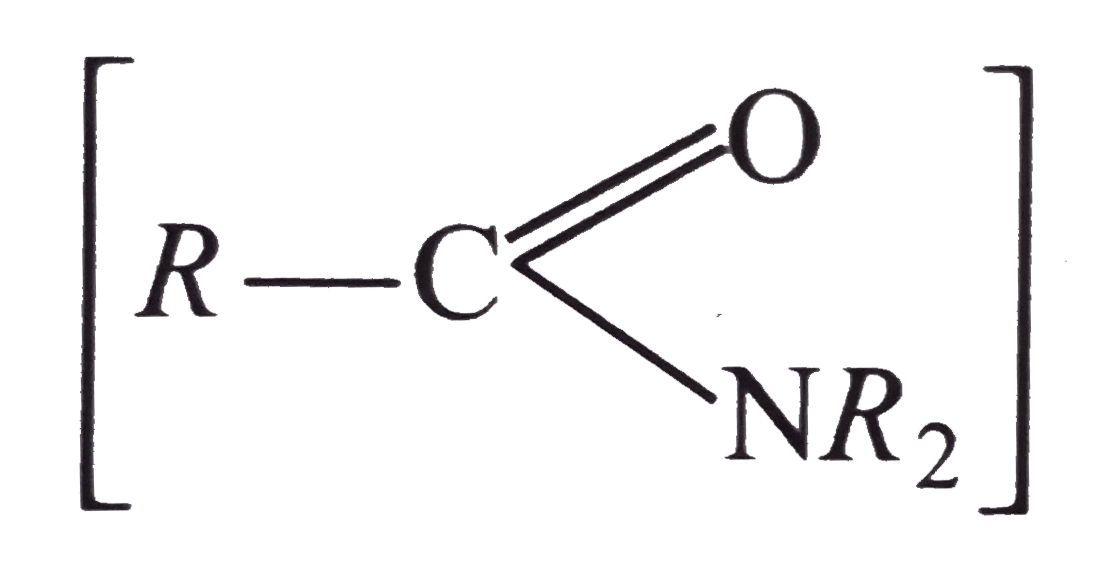Amides with no substitution on nitrogen react with tht: solution of bromine or chlorine in NaOH or KOH to yield aminei through a reaction called as Hofmann's degradation.
R−O∣∣C−NH2+Br2+4NaOHH2O−−→R−NH2+2NaBr+Na2CO3+2H2O
Amides can be reduced to amines having same number of carbon atoms
R−O∣∣C−NH2−[H]−−−→LiAlH4R−CH2−NH2
Carbon dioxide gas is released in above mentioned reaction
The correct Answer is:A
Topper's Solved these Questions
- CARBOXYLIC ACIDS AND THEIR DERIVATIVESBOOK - OP TANDONCHAPTER - CARBOXYLIC ACIDS AND THEIR DERIVATIVESEXERCISE - Integer
4 Videos
- CARBOXYLIC ACIDS AND THEIR DERIVATIVESBOOK - OP TANDONCHAPTER - CARBOXYLIC ACIDS AND THEIR DERIVATIVESEXERCISE - Brain storming problems
30 Videos
- BASIC PRINCIPLES OF ORGANIC COMPOUNDS (MECHANISM OF ORGANIC REACTIONS)BOOK - OP TANDONCHAPTER - BASIC PRINCIPLES OF ORGANIC COMPOUNDS (MECHANISM OF ORGANIC REACTIONS)EXERCISE - SINGLE INTEGER ANSWER TYPE QUESTIONS
4 Videos
- CHEMICAL KINETICSBOOK - OP TANDONCHAPTER - CHEMICAL KINETICSEXERCISE - LINKED COMPRESHENSION TYPE QUESTIONS ( SECTION-VI)
4 Videos
Similar Questions
Amides with no substitution on nitrogen react with tht: solution of bromine or chlorine in NaOH or KOH to yield aminei through a reaction called as Hofmann's degradation.
R−O∣∣C−NH2+Br2+4NaOHH2O−−→R−NH2+2NaBr+Na2CO3+2H2O
Amides can be reduced to amines having same number of carbon atoms
R−O∣∣C−NH2−[H]−−−→LiAlH4R−CH2−NH2
 will undergo Hofmann's degradation.
will undergo Hofmann's degradation.
View SolutionAmides with no substitution on nitrogen react with tht: solution of bromine or chlorine in NaOH or KOH to yield aminei through a reaction called as Hofmann's degradation.
R−O∣∣C−NH2+Br2+4NaOHH2O−−→R−NH2+2NaBr+Na2CO3+2H2O
Amides can be reduced to amines having same number of carbon atoms
R−O∣∣C−NH2−[H]−−−→LiAlH4R−CH2−NH2
N-Methyl aniline can be obtained by using Hofmann's degradation.
View Solution
Knowledge Check
R−O∣∣C−NH2NaNO2−−−−→HClA A is :
AR−O∣∣C−OHBR−O∣∣C−CICR−O∣∣C−NO2D
Me−O∣∣C−O−CH2−CH2−⊕NH2NaOH−−−→Q
AMe−O∣∣C−O−CH2−CH2−NH2BMe−O∣∣C−NH−CH2−CH2−OHC DMeCOONa+HOCH2CH2NH2
DMeCOONa+HOCH2CH2NH2R−O∣∣C−OHH3O+←−−−X[H]−−→RCH2NH2X is ,
AisonitriteBnitrileCnitriteDoxime
Amides with no substitution on nitrogen react with tht: solution of bromine or chlorine in NaOH or KOH to yield aminei through a reaction called as Hofmann's degradation.
R−O∣∣C−NH2+Br2+4NaOHH2O−−→R−NH2+2NaBr+Na2CO3+2H2O
Amides can be reduced to amines having same number of carbon atoms
R−O∣∣C−NH2−[H]−−−→LiAlH4R−CH2−NH2
Iso-cyanates are formed as intermediate in the Hofmann's degradation.
View SolutionAmides with no substitution on nitrogen react with tht: solution of bromine or chlorine in NaOH or KOH to yield aminei through a reaction called as Hofmann's degradation.
R−O∣∣C−NH2+Br2+4NaOHH2O−−→R−NH2+2NaBr+Na2CO3+2H2O
Amides can be reduced to amines having same number of carbon atoms
R−O∣∣C−NH2−[H]−−−→LiAlH4R−CH2−NH2
Benzamide when treated with Br2 in presence of NaOH gives aniline.
View SolutionR−O∣∣C−NH2+xNaOH+Br2→R−NH2+2NaBr+Na2CO3+H2O
Number of moles of NaOH used in above Hoffmann bromamide reaction is :
View SolutionIn the reaction
R−O∣∣C−OHH3O+−−−→X(H)−−→RCH2NH2,'X' is
View SolutionR−O∣∣C−NH2+xNaOH+Br2→R−NH2+2NaBr+Na2CO3+H2O
Number of moles of NaOH used in above Hoffmann bromamide reaction is :
View Solution
